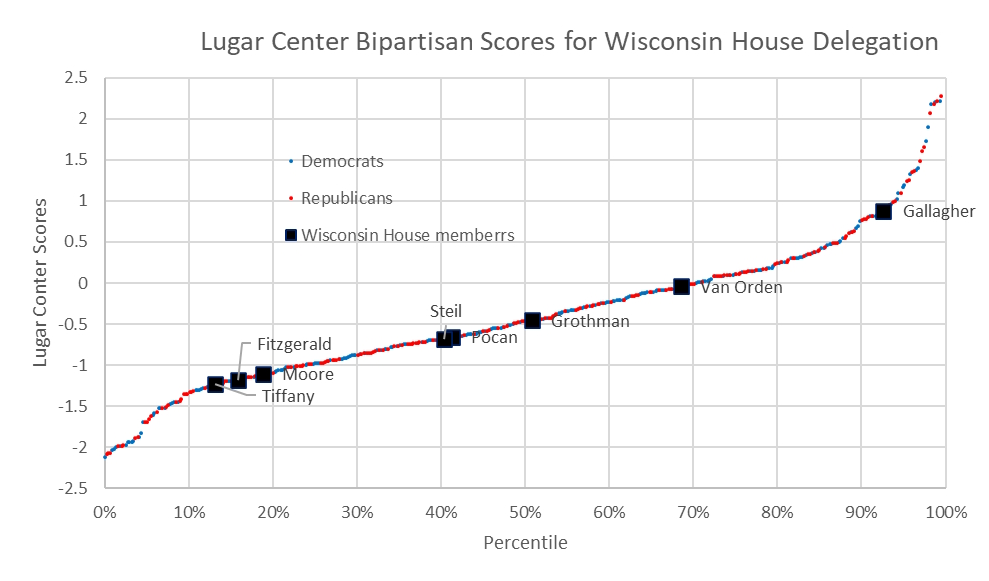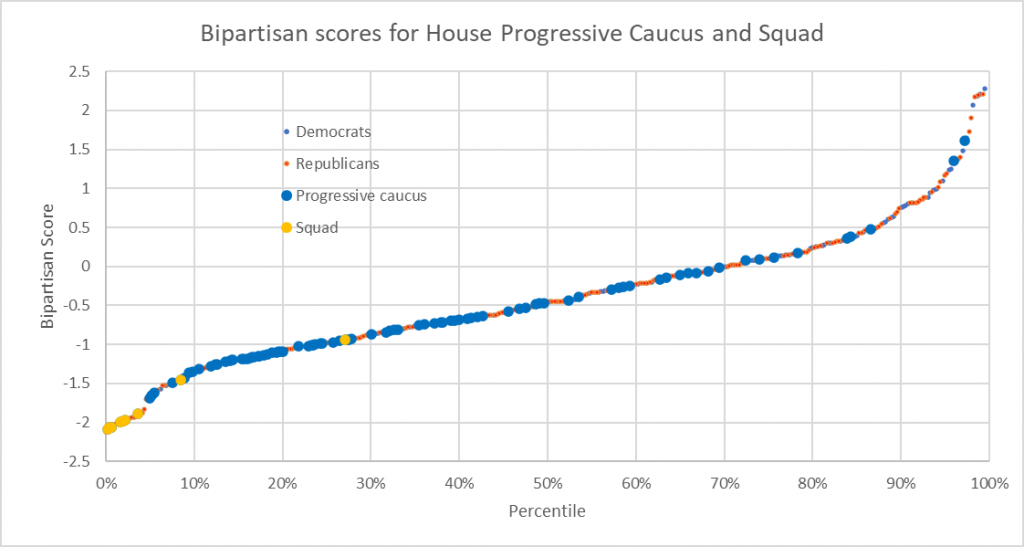How Bipartisan Is Wisconsin’s Congressional Delegation?
Lugar index shows Ron Johnson, Tom Tiffany least bipartisan. Baldwin, Gallagher rank high.
Following each Congressional session the Lugar Center publishes its Bipartisan Index of each member of the US Senate and House of Representatives. The model used by the Center is based on two things: the number of times a legislator of one party co-sponsors a bill introduced by a member of the other party and the number of cosponsors from the other party a legislator’s bills are able to attract.
The graph below plots the scores for members of the House of Representatives for the current year. Democratic representatives are shown using blue dots, Republicans with red dots. Higher Bipartisan Scores, shown on the vertical axis, indicate the member has taken more opportunities to work with members of the other party. On the whole, members of the two parties are pretty evenly distributed when it comes to working with the other party.
According to an email I received from the Lugar Center, the zero point was set at the historical average in designing the scores. In order not to further squeeze the graph, I have left off the two highest scores, 5.6 and 4.3, which were received by two Republican representatives in Pennsylvania and New York. Both serve in districts where Democrats are highly competitive.
The next graph shows the scores received by Wisconsin’s eight members of the House of Representatives. The score for recently resigned Republican representative Michael Gallagher is consistent with his reputation for willingness to work with his Democratic colleagues.
For me, the biggest surprise was the relatively high score obtained by Derrick Van Orden. My impression is that he is a totally partisan. It should be noted, however, that he represents a very competitive district, so he is incentivized to search out measures that would appeal to Democrats.
None of the remaining Wisconsin House members is high on bipartisanship according to their scores. GOP representatives Tom Tiffany and Scott Fitzgerald ranked the lowest, but Democrat Gwen Moore didn’t rank much higher. It seems unlikely that Gallagher’s replacement will match him. From newspaper reports, all three Republican candidates are trying to outdo the others in their loyalty to Donald Trump.
Earlier in this column, I mentioned that there is not a strong correlation between a representative’s political party and willingness to work with members of the other party. However, this generalization does not hold when it comes to the Freedom Caucus. As the next graph shows, members of the Freedom Caucus (represented by red dots) have little interest in working with their Democratic colleagues.
I used a list compiled by Wikipedia of 41 caucus members. The Wikipedia page notes that the Freedom Caucus does not make available a full membership list.
If members of the Freedom Caucus are not big fans of bipartisanship, what about their counterparts on the left? The next graph shows the distribution of members of the House Progressive Caucus. The members of the Progressive Caucus (represented by blue dots) appear much more willing to work with Republicans than are Freedom Caucus members with Democrats. However, as one moves to the right, the density of Progressive Caucus members goes down.
The chart also shows, in yellow, the nine members of the so-called “Squad,” all of whom are also members of the House Progressive Caucus. All but one are in the lower 10% when it comes to bipartisanship.
The next graph plots the bipartisanship scores for the members of the US Senate. As with the House members, Democratic senators are shown with blue dots, Republicans with red.
The distribution of senators by partisanship follows a pattern similar to that of the representatives. However, Wisconsin’s two US senators, shown by black dots, follow very different paths about working with members of the other party. Democrat Tammy Baldwin scores just below the 70th percentile, meaning that about 69% of the senators score lower.
By contrast, Republican Ron Johnson is rated fourth from the bottom, as one of the least bipartisan members of the U.S. Senate. The graph below shows the 10 senators who were rated least bipartisan. Eight of the 10 were republicans.
Bipartisanship brings no guarantee that legislators will always make wise decisions. It is notable that Republicans who supported continued aid for Ukraine received substantially higher bipartisan scores than those opposed to the aid (an average score of -0.72 for opponents compared to 0.05 for supporters).
While the rule has no legal force, speakers ignore it only at the risk of facing an attempt to remove them from office. Ironically, this threat is greater when, as today, the Republican majority is extremely small because the loss of a very small number of members can deny the speaker a majority. The Freedom Caucus used that threat to force their views on the majority of the members.
This attempt was foiled by the Democrats’ decision to support the present Republican speaker, reflected in Marjorie Taylor Green’s accusation that the result was a “uniparty.”
If you think stories like this are important, become a member of Urban Milwaukee and help support real, independent journalism. Plus you get some cool added benefits.
Data Wonk
-
Why Absentee Ballot Drop Boxes Are Now Legal
 Jul 17th, 2024 by Bruce Thompson
Jul 17th, 2024 by Bruce Thompson
-
The Imperial Legislature Is Shot Down
 Jul 10th, 2024 by Bruce Thompson
Jul 10th, 2024 by Bruce Thompson
-
Counting the Lies By Trump
 Jul 3rd, 2024 by Bruce Thompson
Jul 3rd, 2024 by Bruce Thompson



























It seems a certain candidate for US Senator from Wisconsin has a pretty hard sell if he believes he can be more bi-partisan than Tammy Baldwin. But then again, he really isn’t running against Tammy Baldwin. He is running against generic democrat as defined by Fox News. He has already been forced to remove ads because his claims against Sen. Baldwin are not true (and possibly not true about most democrats.)